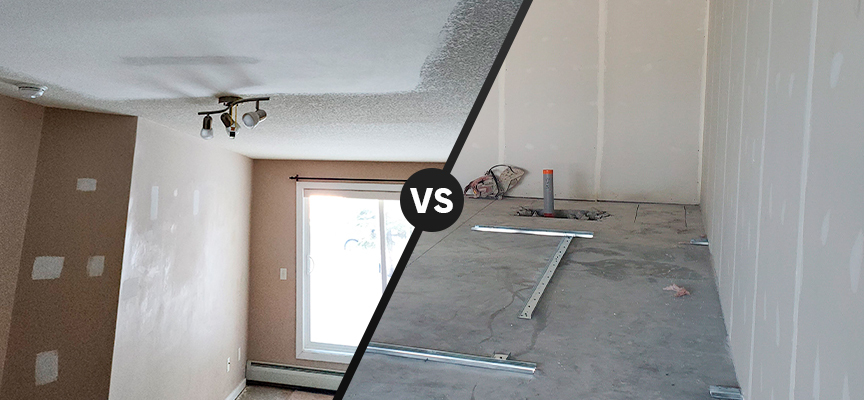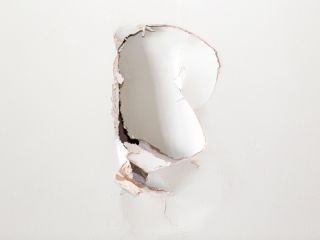Uncover the benefits of hiring top-rated drywall contractors for your next Interior Painting project.
A Comprehensive Guide to Learning Drywall Repair and Installation
This guide provides a comprehensive expedition of drywall repair and installment, providing to both newbies and seasoned experts. It details important devices, techniques for patching and hanging sheets, and the important ending up procedures. drywall contractors. By understanding common risks, people can attain polished results. Grasping these abilities not only enhances one's home however additionally builds confidence in DIY undertakings. What foundational pointers will ensure an effective job from start to end up?
Vital Tools for Drywall Repair Service and Installment
When beginning on drywall repair work and installment, a few important devices can substantially improve the performance and high quality of the work. A drywall blade, usually offered in numerous dimensions, is essential for applying joint compound and smoothing joints. A taping knife is also necessary for feathering sides and ensuring a smooth finish. Furthermore, a drywall saw or utility blade permits for accurate cutting of drywall sheets to fit any room.

Step-by-Step Overview to Patching Holes
Patching holes in drywall is a straightforward procedure that can bring back the wall's appearance and stability. To start, the location around the opening need to be cleaned and any type of loose debris got rid of. For tiny openings, a basic spackle or joint compound can be used with a putty knife. Larger holes may call for a spot; a piece of drywall can be cut to fit the opening, secured with sticky or screws, and after that taped around the edges. Once the spot remains in location, joint substance is used over the patch and feathery out to mix with the bordering wall. After the substance dries, sanding is required to accomplish a smooth coating. Ultimately, the fixed area can be keyed and painted to match the rest of the wall. This technique assures a seamless repair, improving the overall appearance of the drywall and keeping its architectural honesty.
Strategies for Hanging Drywall Sheets
After successfully repairing openings in drywall, the following step includes hanging new drywall sheets to produce a seamless surface. To attain this, one should start by determining the wall surface area accurately and reducing the drywall sheets to fit. It is important to hang the sheets horizontally for better architectural integrity, beginning from the top and working downwards.
Making use of a drywall lift can streamline the process, particularly for ceiling setups. As soon as placed, securing the sheets with drywall screws at intervals of about 12 inches along the edges and 16 inches in the area is important. This ensures a strong hold and minimizes the risk of drooping. For corners, the sheets should be cut to fit comfortably, permitting cleaner joints. Ultimately, it is advisable to surprise the joints in between sheets to reinforce the general structure, producing a more durable coating prepared for these details the following phase in the drywall installment procedure.
Ending Up Touches: Insulation and Mudding
Completing the drywall installment entails the vital actions of taping and mudding, which guarantee a polished and smooth finish. Insulation needs the application of joint tape over the seams between drywall sheets. Drywall Installation Ogden Utah. This tape can be either paper or fiberglass fit together, with each type offering one-of-a-kind advantages. After taping, the following action is mudding, where joint compound, or "mud," is related to cover the tape and fill any kind of flaws
Making use of here are the findings a drywall blade, the compound needs to be spread out evenly, making sure a feathery side to minimize noticeable adjustments. Numerous coats are often essential, with sanding in between each layer to accomplish a seamless surface. Cautious focus throughout this process is essential, as it substantially impacts the final look of the wall surface. With the appropriate method and persistence, completion result will be a flawless structure prepared for painting or ending up touches.
Common Blunders to Avoid in Drywall Projects

Another common blunder is not permitting adequate drying time in between coats, which can trap wetness and jeopardize the coating. Additionally, disregarding to feather the edges correctly can produce visible lines and flaws. Finally, avoiding sanding or using incorrect methods may leave harsh spots. By knowing these pitfalls, individuals can substantially enhance the high quality of their drywall tasks and accomplish a professional-looking finish.
Regularly Asked Inquiries
Can I Fix Drywall Without Expert Help?
Yes, one can repair drywall without specialist assistance. With the right devices, products, and guidance, people can efficiently manage small fixings. Nevertheless, significant damage might call for specialist expertise for suitable outcomes and durability.
How Much Time Does Drywall Substance Take to Dry?
Drywall compound generally takes between 24 to 2 days to dry entirely, relying on elements such as humidity and temperature. Thinner layers might dry out much faster, while thicker applications require even more time for perfect results.
What's the Ideal Kind of Paint for Drywall?
The most effective sort of paint for drywall is usually a water-based latex paint. It offers superb insurance coverage, resilience, and convenience of application, making it ideal for indoor wall surfaces while enabling easy cleaning with soap and water.

How Do I Prevent Mold And Mildew on Drywall?
To avoid mold on drywall, guarantee correct air flow, control moisture levels, use mold-resistant materials, and promptly attend to any type of leaks. Normal assessments and prompt remediation of water damages are likewise necessary for long-term avoidance.
Is Drywall Recyclable After Removal?
Drywall is recyclable after removal, provided it is devoid next page of impurities like mold and mildew, paint, or other harmful products. Recycling centers can refine it right into new items, promoting sustainability and minimizing landfill waste in building and construction.
When beginning on drywall repair and installment, a couple of crucial devices can significantly improve the performance and quality of the job. After effectively repairing holes in drywall, the next step includes hanging new drywall sheets to produce a seamless surface. Completing the drywall installment entails the vital actions of taping and mudding, which ensure a sleek and smooth finish. Accomplishing a refined surface in drywall jobs can be challenging, and a number of usual mistakes can undermine the top quality of the job. Yes, one can fix drywall without specialist aid.